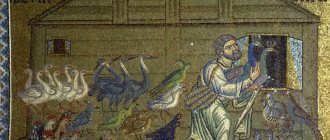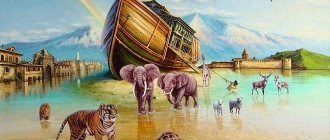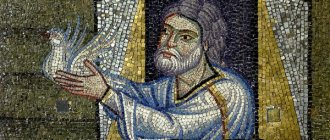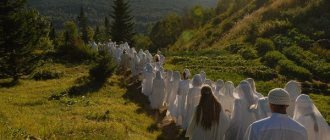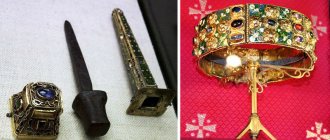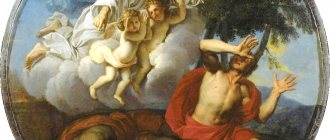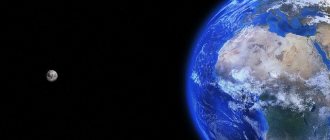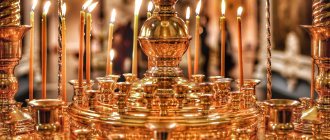I. Aivazovsky “ 9th Shaft
”
Global flood
(in the Bible הַמַּבּוּל, “ha-mabul”) - a catastrophe, terrifying in its scale, that occurred more than 4.5 thousand years ago (according to Young-Earth creationists). The Flood was a large-scale flood that covered the entire surface of the Earth, which was God's punishment for human sins and apostasy from Him. Secular science is skeptical about such statements, not imagining a catastrophe of such enormous proportions.
Currently, society has a significant number of facts that serve as irrefutable proof of the existence of this ancient catastrophe and the accuracy of the Biblical narrative about it.[1][2][3][4][5][6]
Such evidence includes:
- Rapid emergence of the Grand Canyon and massive soil erosion
- Multi-meter layers of coal and oil in the lithosphere (organic matter that died during the Flood)
- Remains of dead marine mollusks on the highest peaks (for example, on the highest Mount Everest)
- Giant “cemeteries” are accumulations of a large number of remains of various living beings. Examples: cemeteries of mammoths[7] and hadrosaurs.
- Mention of the Flood in most ancient cultures (more than 250 peoples from different parts of the Earth have stories about this catastrophe)
- The size of the Earth's population, when studying the growth and systematization of which, it turns out that to such a number (about seven billion) the population could have increased over a period of 4000-4500 years (which does not extend beyond the date of the flood).
- Presence of fossils as such.
There is a well-founded scientific theory that explains all the consequences of the Great Flood, called the theory of biblical catastrophism.
Information from the Bible
Information about the Flood
given in chapters 6, 7 and 8 of the book of Genesis. In particular, it tells about the Ark, the date of the beginning of the Flood and its mechanisms. And also about the death of all land animals, birds and people, except for those eight people and several hundred pairs of animals who were in the Ark, built by the pious Noah according to God's instructions.
| And the Lord saw that the wickedness of man was great on earth, and that every thought and intent of their hearts was evil at all times; and the Lord repented that he had created man on earth, and was grieved in His heart. And the Lord said: I will destroy from the face of the earth man whom I have created, from man to beast, and the creeping thing and the bird of the air I will destroy, for I have repented that I created them. (Gen.6:5-7) |
.
A dove sent from the Ark. Engraving by Gustav Dore
| In the six hundredth year of Noah's life, in the second month, on the seventeenth day of the month, on this day all the sources of the great deep burst open, and the windows of heaven were opened; and rain fell on the earth for forty days and forty nights. … And the flood continued on the earth for forty days, and the waters increased, and lifted up the ark, and it was lifted up above the earth; But the waters increased and greatly increased on the earth, and the ark floated on the surface of the waters. And the water on the earth increased exceedingly, so that all the high mountains that were under the whole sky were covered; The water rose above them fifteen cubits, and the mountains were covered. And all flesh that moved on the earth lost its life, and birds, and cattle, and wild beasts, and every creeping thing that crawled on the earth, and all people; everything that had the breath of the spirit of life in its nostrils on the dry land died. Every creature that was on the surface of the earth was destroyed; from man to livestock, and creeping things, and birds of the air, everything was destroyed from the earth, only Noah remained and what was with him in the ark. The water increased on the earth for one hundred and fifty days. (Gen.7:11-24) |
Global flood
was truly a monumental disaster and lasted more than ten months:
| In the year six hundred and one, by the first day of the first month, the water on the earth dried up; and Noah opened the roof of the ark and looked, and behold, the surface of the earth was dry. And in the second month, by the twenty-seventh day of the month, the earth was dry (Gen. 8:13-14) |
Flood
Table of contents
Generation of the Flood ↓
Noah is the righteous man of his generation ↓
World Flood ↓
World after the Flood ↓
Generation of the Flood [↑]
The weekly chapter of Noah tells of the Flood that G-d brought upon the earth for the sins of that generation.
The generation of the flood committed both minor and major sins. But the Almighty, possessing long-suffering, forgave them their sins... up to a certain point.
GOD TOLD NOAH: THE END OF ALL FLESH HAS COME BEFORE ME, FOR THE EARTH IS FILLED WITH PLAY ( Genesis 6:13
)
Rabbi Yochanan said: “Come and see the power of robbery. The generation of the Flood violated everything, but the decision about their end was not signed until they were guilty of theft" ( Sanhedrin
).
We must realize how serious it is to steal even the smallest amount and move away from this sin.
In this generation, when someone offered beans for sale, passersby took them without asking for an amount less than a pruta (the smallest coin), then the court could not force the thief to return it. And one after another they robbed the seller until there was not a bean left. But he could not demand that the thieves be punished and the property returned ( Midrash Bereshit Rabbah
).
R. Ze'ev Einhorn
in the commentary he adds that people of this generation certainly stole on a big scale.
In secret, everyone stole as much as they could. And fewer rods were stolen publicly, and they put up with it ( Pirush maharzu
).
R. Shalom Shwadron
remarked: “More than once I have seen people enter a shop, take some food and not pay. Often the owner would like to be paid, but it is inconvenient to ask for money for such an amount. This must be condemned. This is what they did in the generation of the Flood.”
The generation became corrupted, and G‑d destroyed it with the Flood, but saved Noah and his family.
According to the Torah, moral decay began with the fact that “the sons of rulers...took for themselves women, all whom they chose” ( Genesis 6:2, Rashi
).
“Any breach begins with the leaders of a generation,” and then the sons of kings and nobles began to take other people’s wives by force. They also committed fornication with men and with livestock ( Bereishit Rabbah 26:5, Maarzo
) - the wicked “crossed livestock with wild animals and animals with livestock, and all animals with people, and people with all animals” (
Sanhedrin 108a
).
Many women in that generation walked around exposing their flesh and making up their eyes, like harlots, and men were defiled by all kinds of debauchery - openly and right on the street, having sex even with their mothers and daughters ( Pirkei derabi Eliezer 22
).
And it was those who were called upon to monitor the observance of the law who were especially outrageous - and there was no one to stop them ( Ramban, Bereshit 6:2
).
The Talmud states that although the generation of the flood transgressed every conceivable prohibition, their sentence was sealed precisely for robbery ( Sanhedrin 108a
).
In the Torah itself, the main crime of this generation is called hamas
(“robbery”; see Bereshit 6:13), and commentators explain that the concept of
hamas
also includes petty thefts for which it is impossible to go to court to restore justice.
It was this type of crime that was especially common in the generation before the flood: this “robbery” ( hamas
) was committed openly, in the light of day, with general consent (
Bereishit Rabbah 31:5, Nekhmad Lemar'e
).
By definition p. Ovadi Seforno, robbery took on a total character, and people stopped seeing evil in it: after all, “everyone stole from each other” ( Seforno, Bereshit 6:13
).
And the author of the book Ohr Achaim, Rabbi Chaim ibn Athar, adds: “In the generation of the flood, everyone stole what they could, ... and if the situation was such that it was impossible to rob or steal, they resorted to fraud and deception” ( Or Achaim, Bereshit 6 :13
).
However, according to a broader definition, the concept of Hamas
includes not only robbery, but also “all kinds of abominations” (
Maarzo, Bereshit Rabbah 31:1
) - including idolatry, bloodshed and debauchery.
According to the midrashic testimony, the inhabitants of the earth are literally “mired in debauchery,” and “depravity ( znut
) inevitably leads civilization to universal destruction” (
Bereshit Rabbah 26:5, 31:6
).
And yet, “the generation of the flood was not wiped out from the face of the earth until they began to draw up marriage contracts between men and between people and livestock” ( Bereishit Rabbah 26:5; Rashi, Chulin 23a, “Ki Ishchit”
).
And since the people of that generation not only succumbed to their passions from time to time, but debauchery acquired the force of law among them, repentance became practically impossible ( Maarzo on Bereshit Rabbah 26:5
).
The flood destroyed all life on earth. Only Noah and those who were with him in the Ark were saved.
Noah is the righteous man of his generation [↑]
Noah (Noah) was born in 1056
year when his father Lemech was 182 years old (
Genesis 5:28
).
He was born without a foreskin - “circumcised” ( Avot derabi Nathan 2:5; Shocher tov 9
).
He was the great-grandson of Hanoch and grandson of Methuselah. His mother Eshmoah, daughter of Elishua, son of Hanoch, married Lemech in 1055 /2705 BC/ ( Sefer ayashar; Seder adorot
).
Methuselah called him Noah, and his father gave him the additional name Menachem, saying: “This one will bring us comfort ( yenakhmeinu
)» (
Bereshit 5:29; Sefer ayashar; Yalkut Shimoni, Bereshit 42
).
He studied with his grandfather Methuselah, who was the ruler of all mankind ( Seder Hadorot
).
For many years, Noah lived in solitude, trying to protect himself from the influence of the wicked of his generation. He intently studied the books of Adam and Hanoch in order to learn the ways of serving the Creator ( Zohar 1, 58b
), - and the Torah says that “Noah found favor in the eyes of the Lord” (
Bereishit 6:8
).
IN 1536
year /2224 BC/ Noah was awarded a prophecy: the Almighty revealed to him that if humanity does not repent of its crimes and does not return to a righteous lifestyle, then after 120 years it will be destroyed by the waters of the flood (
Genesis 6:3 , Rashi; Sefer ayashar
).
After all, the Creator “never carries out judgment in the world until He announces it and notifies the defendants,” as He “notified the generation of the flood through Noah” ( Zohar 1, 58a
).
The Talmud says that “the sentence was passed on Noah also,” because since the world is judged by the majority, and most of his contemporaries were wicked, the sentence applied to all humanity ( Sanhedrin 108a, Yad Rama and Maarsha
), - but he and his family were pardoned (
Sanhedrin 108a, Yad Rama and Maarsha
).
And although the Torah says: “Noah is a righteous man” ( Genesis 6:9
) and “I saw you righteous in this generation” (
ibid. 7:1
), nevertheless, his righteousness was not enough to protect him from destruction contemporaries (
Zohar 1, 67b-68a
).
And, according to some Talmudic sages, Noah was a “righteous man” precisely in his generation: in comparison with the complete wicked people around him. But others believe that if Noah managed to remain righteous among the complete wicked, then, even more so, he would have become a great righteous person in another, not so corrupt generation ( Sanhedrin 108a; Rashi, Bereshit 6:9; Zohar 1, 67b
).
In any case, he was saved from the waters of the flood not for his own merits, but because in the future Moshe Rabbeinu (Prophet Moses) was to come from him, through whom the Torah would be given to the Jewish people ( Bereishit Rabbah 26:6
).
That same year, the Almighty commanded Noach to build a large ship - an ark, on which he could be saved on the day of the global catastrophe ( Bereishit 6:14, Rashi; Seder Hadorot
).
The Almighty said to Noah:
MAKE YOURSELF AN ARK FROM GOPHER WOOD ( Genesis 6:14
)
God could have saved Noah in many ways. Why did He make him build the ark?
Rashi explains: to arouse people's curiosity. Watching Noah build the ark for one hundred and twenty years in a row, people will be surprised and ask: “Why are you doing this?” And Noah will answer: “The Holy One, blessed be He, will soon bring a Flood upon the world,” perhaps they will then repent ( Sanhedrin
).
The aroused interest gives a chance to find a way to the heart.
But the people of Noah's generation did not repent of their atrocities. And the Flood destroyed them.
To Noah, who was supposed to survive the Flood in the ark, God said:
TAKE WITH YOU ALL THE FOOD THEY EAT AND STORE. AND IT WILL BE FOOD FOR YOU AND FOR THEM ( Genesis 6:21
)
At first glance, the words “and it will be food for you and for them” are unnecessary.
R. Elhanan Wasserman
offers an explanation: Describing the climate and fertility on the earth before the Flood, the midrash says that then the earth gave birth to incomparably more than now. Noah, who was a prophet, knew that after the Flood the earth would no longer be so fertile. But he was instructed to take just enough to feed himself and his family during the Flood. - When others suffer, we should not seek pleasure.
The Flood [↑]
Following the direct command of the Almighty, Noah (Noah) built an ark and placed in it large supplies of food for his family and those animals and birds that were to be collected in the ark. In addition, he brought seedlings of fruit plants into the ark to plant them after the flood ( ibid. 31:14, 36:3
).
On the seventeenth day
month of Cheshvan
1656
/2104 BC/ Noah and his family entered the ark.
And after them, obeying the silent order of the Creator, pairs of all animals and birds intended for salvation were gathered in the ark ( Bereishit 7:7-11, 13-16; Seder Olam Rabbah 4
).
That day, heavy rain began throughout the land, and the water rose significantly, flooding low places. Frightened people ran to Noah's ark, and gradually about seven hundred thousand people gathered there. They demanded: “Open the ark to us, and we will be saved with you. Why do we have to die?!”
“You all rebelled against the Creator and claimed that He did not exist,” Noah reminded them. “And now He rewards you for your evil, sweeping you off the face of the earth.” Now is coming what I have been warning you about for one hundred and twenty years - but you have not listened. And now you want to survive on earth?!”
And the people answered Noah: “Now we all repent and return to the Creator. Open the ark for us so that we do not perish!” “Only now, having seen trouble in the face, are you ready to repent,” Noah told them. - But why didn’t you return to the Almighty during those one hundred and twenty years that He gave you to repent? And on this day G‑d will not listen to you, and today your words will no longer help.”
And then the people approached to forcefully open the ark and, having dealt with Noah, hide from the approaching water. But the Creator sent wild animals against them, who also tried to escape the waters of the flood by the ark. Predators devoured people, and they fled in different directions ( Sefer Ayashar; Tankhuma, Noach 7; Yalkut Shimoni 57
).
For forty days the rain intensified. It was joined by underground streams gushing to the surface, and “the ark floated on the water” ( Genesis 7:18
).
The waters rose fifteen cubits higher than the highest mountains - and “all flesh perished: ... from man, to beast, to reptile, to bird of the air, ... and only Noah and those who were with him in the ark remained (alive)” ( there same 7:20-23
).
All these days the storm tossed the ark like a piece of wood, threatening to break it. The animals howled and growled in their compartments, and Noah and his sons, in trepidation and fear, prayed to the Creator for deliverance from certain death ( Seder Hadorot
).
Forty days later, 27 Kislev 1656
, the rains stopped, but only after five months the waters, absorbed into the ground, began to slowly descend.
On the seventeenth of Sivan, “the ark descended...on Mount Ararat” ( Bereishit 7:12, 24, 8:3-4, Rashi; Seder Olam Rabbah 4
).
All the days and nights spent in the ark, Noah and his family members, without knowing rest, looked after the animals and fed them: after all, some animals feed only during the day, while others feed at night. One day Noah was late in feeding the lion, and the enraged beast seriously injured his leg ( Tankhuma, Noah 9
).
On the first day of the month of Av, the tenth month from the beginning of the flood, from the window of the ark “the tops of the mountains became visible” ( Bereishit 8:5, Rashi; Seder Olam Rabbah 4
).
Then Noah released a dove to see if the water had receded:
BUT THE DOVE FOUND NOT A PLACE FOR HIS FOOT TO REST, AND IT RETURNED TO NOAH IN THE ARK, FOR THERE WERE WATERS ON THE SURFACE OF ALL THE EARTH; AND HE RESPECTED HIS HAND, TOOK HIM AND BROUGHT HIM INTO THE ARK (Genesis 8:9)
Rabbi Naftali Tzvi Yehuda Berlin, head of the Volozhin yeshiva, notes that the dove did not fly into the ark. I just flew up to him. When he returned, there was nothing in his mouth, and he was afraid that his owner would not let him back. But Noah knew how to sympathize, stretched out his hand and took the dove into the Ark so that it could rest after a hard journey.
Rabbi Berlin adds: We must learn from Noach. If a person has not completed an assignment due to circumstances beyond his control, thank him as if he had completed it.
Two months later, on the first day of the new month of Tishrei, 1657
year, “Noah took the lid off the ark and saw that the surface of the earth began to dry up” (Bereishit 8:13).
And finally, on the 27th day of the month of Cheshvan, a full solar year from the beginning of the flood, Noah and his family left the ark ( ibid. 8:14-18, Rashi; Seder Olam Rabbah 4
).
World after the Flood [↑]
When Noah came out of the ark and saw the world destroyed by the waters, he, sobbing, reproached God: “You, who were called the Merciful, should have had mercy on Your creatures!” “Crazy shepherd,” G-d objected to him, “now you are telling Me about this?!” Why were you silent when I warned you about the flood? After all, I called you “righteous” precisely so that you would ask for mercy for all mankind. But you heard that you would be saved in the ark, and you did not ask for others, but built the ark and were saved! And now you reproach Me?!” ( Zohar Hadash, Noach 23a
).
And since Noah, having received the prophecy that the Creator would destroy humanity, did not even ask for mercy, the Almighty calls the destroying waters of the flood “the waters of Noah” ( Yeshaya 54:9
) - as if it was Noah who flooded the world (
Zohar 1, 67b
) .
Descending from the mountains of Ararat, Noah and his family traveled in a southwestern direction, reaching the country where the first people, Adam and Chava, lived and were buried. During the days of the flood, only over this land there was no rain, and powerful underground waters did not break out to the surface there. And although this land was flooded with water that penetrated from the surrounding countries, trees still survived there. In the rest of the world, not only trees were broken and uprooted, but even stone millstones were crushed by the flood ( Pirkei Derabi Eliezer 23; Vayikra Rabbah 31:10; Ramban, Bereshit 8:11
).
After the flood, Noah and his descendants were allowed not only plant foods, but also meat. Therefore, to the six commandments given to Adam, a seventh was added: the prohibition of eating meat torn from a still living animal - “ ever min achai” (ibid. 9:3-4; Rambam, Melachim 9:1
). Thus, all his descendants - all humanity - were given seven commandments (7 laws of Noach).
In subsequent years, Noach settled in a country that later became known as “Italy.” There he devoted all his time to the attainment of wisdom ( Seder Hadorot
).
In particular, he compiled a book on medicine, in which he included healing methods and recipes for medicinal potions, which he received from the angel Rephael (Otsar Ishei HaTanach, Noach
).
From the descendants of the three sons of Noah, seventy major nations subsequently descended: 14 from Yephet, 30 from Ham and 26 nations from Shem ( Bereshit 10:1-32; Seder Olam Rabba 1; Seder Adorot
).
Noah died in 2006
year /1754 BC/ at the age of 950 years (
Bereishit 9:29; Seder Hadorot
).
According to numerous sources, the remains of Noah's Ark have survived to this day. The Almighty saved them so that evidence of the global flood would remain on earth ( Yalkut Shimoni, Beshalach 256
).
The historical chronicle Seder Hadorot states that the “Mounts of Ararat” referred to in the Torah verse are four peaks arranged in two pairs. The mountain range on which the ark landed at the end of the flood was called Kadron in ancient times, and the largest mountains were Cardenia and Armenia. Not far from them was the capital city of Armenia ( Targum Yonatan, Bereshit 8:4
).
Comparison of different Flood stories
The story of the Great Flood is found among dozens of peoples of the world, living tens of thousands of kilometers from each other.
The biblical story of Noah also reveals special similarities with the legends of other Near Eastern peoples.[8] The oldest dated cuneiform Babylonian flood tablet dates back to c. 1637 BC e.
Fragments of a Sumerian poem were also found, which apparently influenced the creation of the Babylonian work [9] (the tablet dates back to the 18th century BC).
The Sumerian legend itself is very ancient; its final literary processing dates back to the III dynasty of Ur.[10] Comparison of flood stories
| Subject | Bible story | Sumerian legend, III millennium BC. e. (preserved in fragments of the 18th century BC) | Babylonian legend, XVIII-XVII centuries. BC e. |
| Source | Book of Genesis | Cuneiform tablets found during excavations of Nippur. | 1) Babylonian historian Berossus, III century. BC e., reached in the retelling of Greek historians; 2) Cuneiform tablets from the library of King Ashurbanipal, inserted story in Table XI of “The Song of Gilgamesh”; 3) The same, different version of the text. |
| Character | Noah , 10th generation after Adam | Ziusudra , king and priest of the god Enki Ziusudra literally translated from Sumerian means "finder of the life of long days" | 1) Xisutrus (Ziusudra), 10th king of Babylon; 2) Ut-write translated from Akkadian: “he who found breath,” son of Ubar-Tutu, ancestor of Gilgamesh; |
| saving god | God | Enki (Eya) | 1) Kronus; 2) Ea |
| Order | Build an ark, take your family and animals with you | There is a gap in the text, but it is clear that it is close to the Akkadian version: the god’s address to the wall of the hut, which Ziusudra hears, is mentioned | The gods make a decision at the council, but Eya, secretly from the other gods, informs their decision to Ut-napishtim and advises them to build an ark and take their family and animals with them. |
| Duration of shower | 40 days and 40 nights | 7 days and 7 nights | 7 days and 7 nights |
| Birds | Releases a raven, then releases a dove three times | (text missing) | 1) several birds; 2) dove, then swallow and raven |
| Mooring location | Ararat | 1) Armenia; 2) Nitsir | |
| Sacrifice after salvation | Building an altar and making a sacrifice | Sacrificing bulls and sheep | Building an altar and offering sacrifices in the form of incense from myrtle, reed and cedar |
| Blessing | God makes a Covenant with Noah and blesses him | An and Enlil grant Ziusudra “life like the gods” and “eternal breath” and settle him and his wife on the island of the blessed Dilmun (Tilmun in the Akkadian version) | Ut-napishtim and his wife (or Atrahasis without a wife) upon leaving the ship receive the blessing of the god Ellil |
| Additional materials | Tablet with the story of Gilgamesh |
Such similar content is easily explained by the fact that all subsequent generations of people descended from members of Noah’s family (8 people in total), according to the biblical narrative.
see also article: Anthropology
Flood in the Bible.
As we have already said, the biblical story of the Flood is told in the book of Genesis.
Read the chapters telling about the Flood:
| Genesis chapter 6 | Genesis chapter 7 | Genesis chapter 8 |
The Great Flood is a monstrous catastrophe in biblical history, the consequence of which was the flooding of the entire planet and the death of almost all living things. During the flood, water increased not only due to the continuous rain for 40 days, but also due to the discovery of giant underground springs.
The creation of the world in God's plan presupposed perfection and universal harmony. Everything changed after the fall of Adam and Eve. Evil and sin have settled on Earth. The first result was the murder of Abel, committed by his blood brother out of jealousy. Some lived according to God, others lived in sin. Over time, there were so many sinners and unbelievers that the Lord decided to cleanse the Earth by sending the Great Flood.
All the “fountains of the deep” were opened, and the “windows of heaven” were opened. It was raining. unprecedented strength, and he walked for 40 days. Water oozed from the depths of the Earth for 150 days. After this, the water began to decrease. It took seven months for the peak of Ararat to emerge from the water. Noah came out of the ark and built an altar to the Lord and made a sacrifice. The Lord, seeing Noah’s grateful heart, decided never to repeat the Flood again.
... I will no longer curse the earth for man, because the thought of man’s heart is evil from his youth; and I will no longer smite every living thing, as I have done. (Genesis chapter
Finds and facts
- In 1927-1928, during the excavations of ancient Ur, Leonard and Catherine Woolley excavated the so-called “royal tombs of Ur,” which apparently dated back to the Sumerian period. Unexpectedly, right below them, the researchers stumbled upon a 20-meter layer of alluvial (alluvial) clay without any traces of human presence. The most likely explanation for the appearance of such a layer in this area could be a flood that was catastrophic in its severity and consequences.[11]
- The largest cemetery of hadrosaurs was found in 1990 during the construction of a highway near Kundur station (Amur region, Russia). The layer, which stretches along the road for about 600 meters and is 50 meters wide, is literally filled with tens of thousands of bones, which lie in a disorderly mass; individual femurs, shins, a lot of vertebrae and ribs, fragments of jaws are especially common, as if animals were torn apart and scattered in different directions. The deposits in which the bones are buried are lumpy variegated clays with unrounded fine gravel - typical in places where powerful mud flows descend. The sudden catastrophe crushed huge carcasses, tore off long tails, legs and front paws, and broke fragile openwork skulls and pelvic bones. So again and again paleontology confirms the biblical story of the Great Flood that destroyed the first world. [12]
What is a global flood
The story of the global flood is widespread among various peoples of the world. In the Christian religion, this plot occupies a special place. Believers view it as a large-scale death of people due to God's punishment for unbelief and lawlessness. The Flood as a historical fact and confirmation of its reality are questioned by skeptics.
Noah gathers animals for the Ark (medieval mosaic)
The ark
Main article
:
Noah's Ark
Noah's Ark
(Hebrew: תיבת נח - Tevat Nōakh, Arabic: سفينة نوح Safīna Nūḥ) was a huge ship that God ordered Noah to build. This is recorded in the Book of Genesis, beginning with chapter 6. The purpose of the ark was to preserve Noah and his family from the impending global flood, as well as to preserve the pairs of every species of land animal for the continuation of life.
| And God said to Noah: The end of all flesh is come before Me, for the earth is filled with evildoings from them; and behold, I will destroy them from the earth. Make yourself an ark of gopher wood; make compartments in the ark and coat it with pitch inside and outside. And make it this way: the length of the ark is three hundred cubits; its breadth is fifty cubits, and its height thirty cubits. And thou shalt make a hole in the ark, and thou shalt make it a cubit at the top, and thou shalt make a door into the ark at the side thereof; arrange lower, second and third housing in it. And behold, I will bring a flood of water upon the earth, to destroy all flesh in which is the spirit of life under the heavens; everything on earth will lose life. But I will establish My covenant with you, and you and your sons and your wife and your sons’ wives will come into the ark with you. Bring also into the ark two of every living creature, and of every flesh, so that they may remain alive with you; let them be male and female. Of birds according to their kinds, and of cattle according to their kinds, and of every thing that creeps on the earth according to their kind, two of every kind will come to you, so that you may live. (Gen.6:20) |
Ark size
The Ark was one of the largest ships of antiquity, its characteristics in the modern system of measures (if we take 50 centimeters as an “elbow”) are comparable to the dimensions of modern ocean-going vessels:
- Length: 150 meters
- Width: 25 meters
- Height: 15 meters
There is a theory (accepted by some creation scientists such as Kent Hovind, Carl Boe) that there were much larger people on Earth before the Flood. The Bible refers to them as "Giants" or "Sons of God" (see Psalm 19:6, Genesis 6:2). The great growth is explained by the fact that before the flood there were different living conditions than now. If a person is taller, then the elbow will be longer. Thus, the exact size of Noah's Ark cannot be determined. Only one thing is clear, he was huge. Some Bible critics point out that it was impossible to preserve all the diversity of the animal world in a small ark. However, this was not necessary, since the engineered variability of living organisms made it possible to preserve only genera. The size of the ark was 300 x 50 x 30 cubits (Gen. 6:15), which is approximately 150 x 25 x 15 meters, that is, its volume was ultimately equal to 43,500 m3 - the same as 550 ordinary cattle cars, in each of which can accommodate 240 sheep. If you compare all the animals that could have been on the Ark, from a mouse to an elephant to a baby dinosaur, the average animal would be about the size of a sheep. Consequently, 16,000 animals occupied only 1,200 m3 of space. This would leave space in the Ark equivalent to 5 trains of ~100 cars each. It could easily fit Noah and his family, food and feed supplies, and a waste department.
Detailed research on the size, capacity, contents, functionality of the Ark is carried out by Karl Bo.
The Flood - a biblical story
The Bible tells us that the first generations of people on earth after the expulsion of Adam and Eve from Eden were distinguished by great longevity. It was given to humanity for the rapid repopulation of the earth and for the preservation of faith and memory of the promise of the Deliverer. Thus, in every family over the centuries, knowledge about God and the creation of the world was passed on to subsequent generations.
However, long life became the reason for people to take root in bad customs and corruption. Death was rare, which allowed people's conscience to become dull. Evil and vices multiplied, punishment for them and deliverance from sins seemed distant, almost inaccessible. And the time came when evil spread throughout the earth, there was a complete corruption of people who were no longer capable of repentance and correction. Then the Lord decided to put to death all life on earth, to wash away wickedness and corruption from the earth.
However, among all people there was a blameless man who found grace with God, the righteous Noah. Then God told Noah to build an ark, because a great flood would be brought upon the earth. God determined 120 years during which humanity could repent of its sins. Noah had to complete the construction of the ark during this time.
Flood Mechanisms
There is a version that before the Flood, the Earth was surrounded by a large number of small particles of ice, held in orbit as a result of the Meisner effect. This water shell served as protection from solar radiation and ensured uniform distribution of heat on the surface of the Earth (the existence of a warm climate at the poles is confirmed by the frozen remains found there: crocodiles, palm trees and other tropical inhabitants). Water contained in the form of ice could account for a significant portion of the precipitation that fell during the flood (rain that lasted 40 days).
Events that accompanied the Flood:
- Exit from underground groundwater
- movement of tectonic plates
- multiple volcanic eruptions
- heavy rainfall
- a rise in the water level in the World Ocean to an unprecedented level (the entire land surface was covered)
Noah, Sumerian rescuer or trader?
First of all, looking at Noah himself, we do not see any biblical clothing on him, he is a normal Sumerian man who wears eyeliner, shaved the hair on his head, and wears a skirt. The Epic of Gilgamesh mentions that the Sumerian Noah was a very wealthy man who had silver and gold - which only rich merchants paid for.
Most likely, the Sumerian Noah was a winegrower, but a rich and wealthy merchant who was not building an ark to save him from the flood, but a merchant ship on which he planned to transport all kinds of cargo - grain, beer, livestock. All large ancient cities such as Ur are located on the Euphrates, so transporting goods by water was more convenient, faster and cheaper, and also safer than caravan routes by land.
But here the question arises, how big was the ship of the merchant Noah? The Sumerians used different boats, small reed and large wooden six-meter barges.
All Babylonian texts say that the ship was huge, which is not an indication of size. Probably, traders needed an incredibly large barge to transport more cargo. However, in those days they did not yet know how to build large ships, so how then could the Sumerians build a large ship?
Perhaps they fastened together several small boats like pontoons. The Epic of Gilgamesh reports that the rescue ship was sectional, which was most likely built as a pontoon, and the ark was built on this structure.
Well, since this Sumerian ark was a trading ship, it can easily be assumed that the Sumerian Noah loaded livestock, grain and beer onto it for sale, but not at all as described in the Bible. And yet, according to the epic, the Sumerian Noah was not just a wealthy merchant, he was the king of the city of Shuruppak.
Moreover, the king also obeyed the accepted laws, and if he did not deliver the cargo on time, he would not only face ruin, but also the loss of the throne.
Clay tablet from Shuruppak, around 2600 BC
Yes, in Sumer there was a law that is now difficult to believe; in those days, anyone who did not repay the debt, and even the king, was struck down in all rights and sold into slavery. What does the flood have to do with it, you ask? We can assume that the Sumerian Noah could have been a victim of natural disasters.
The thing is that in some places the Euphrates was navigable only during the flood period, which means Noah had to carefully calculate the time of departure. Around 3 millennia BC, a severe flood occurred in Shuruppak and some other Sumerian cities (Ur, Uruk and Kish), which was confirmed by Schmidt’s expedition, finding silt deposits at a depth of 4-5 meters.
In July, melting glaciers from the mountain peaks filled the Euphrates, then the river became deep enough to accommodate large ships. Although there was always a risk that if heavy rains had started in Shuruppak, the waters of the Euphrates would very quickly turn into raging torrents.
The danger of becoming a victim of the July rains was low; often there was prohibition at that time, and there was no serious precipitation. Such catastrophic natural disasters happened extremely rarely in Mesopotamia, maybe once every thousand years, and if such a disaster happened, it would definitely be mentioned in the chronicles, right?
The old epic tells us that on the day of the flood, the Sumerian Noah and his family had a feast on the ship, when suddenly, out of the blue, the weather suddenly worsened and a heavy downpour began, leading to a flood. Such a downpour did not bode well for Noah and his family, since in mountainous areas it could quickly lead to a flood. Although Mesopotamia is not located in the tropics, it is known that hurricanes and tropical rainstorms occurred in these latitudes.
Remembering that time six thousand years ago, one recalls the warmer and more humid climate of these places and the rare but powerful tropical downpours. In the past, such downpours led to catastrophic consequences, and it was precisely such events that were described in epics, since they go beyond the ordinary. And if such a tropical downpour coincided with the melting of glaciers in the mountains, then the waters of the Euphrates could well flood the lowland regions of Mesopotamia.
Scientists say: Artificial intelligence is a threat to humans, warns Stephen Hawking
Biblical records claim that the rain did not stop for 40 days and nights, while the Babylonian epic speaks of only seven days of rain.
But in fairness, it should be noted that even a one-day heavy rain could lead to catastrophic consequences, filling the banks of the Euphrates. Thus, the barge of the Sumerian Noah could find itself at the mercy of the raging waves (not to be confused with the biblical one). The next day, Sumerian Noah and his family could no longer see the earth; water stretched all around them. After the downpour ended, Sumerian Noah and his family waited until the big waters went away so they could land on the shore again. Then they did not yet know that their misfortunes were just beginning and that the “Book of History” was waiting for them.
In all versions of this story, only one thing remains unchanged: they did not see land for a week. The Bible preserves the memory of the Flood, but another explanation can be given for this:
Noah's family believed that their ship was carried by the waters of the Euphrates, since the water was fresh. But the Babylonian narrative says that the water was salty, which means that the Ark of Sumerian Noah left the waters of the Euphrates and was carried into the Persian Gulf.
The Epic of Gilgamesh says that the sea spread out on all sides before Noah. We don’t know how long Noah’s ship was in the Persian Gulf, the Bible says more than a year, and those who survived could really believe that there was no more land. But the Babylonian epic says - a little more than a week.
But in any case, Noah and his family faced a serious problem; they were surrounded by salt water. They had no fresh water; the only thing they could do to quench their thirst was drink beer, which was plentiful on the ship. By the way, beer is not a bad alternative, since it is known to be 98% water, in which many nutrients are dissolved.
The Bible mentions that Noah's ark stopped on the slope of Mount Ararat, and if there was no universal flood, then the ark could have ended up in a completely different place. Ararat, located much north of ancient Shuruppak, the ark could have been carried away about 750 km. and he could actually end up in the waters of the Persian Gulf. The Biblical story of Noah ends here, but in the Babylonian narrative, Noah's adventures take a longer path.
Consequences of the Flood
Main article
:
Catastrophism theory
As a result of the Flood, most land living creatures, birds and plants (except for those who remained in the Ark) perished. Currently, mass graves of many animal species have been found. Such cemeteries were formed due to the simultaneous death of a large number of living organisms.[13][14] Thus, on the territory of Russia, evidence of mass death of animals as a result of the disaster was found, a hadrosaur cemetery in Kudur, the Amur Territory and the Berelekh mammoth cemetery in Altai[15].
After the completion of the Flood, numerous changes occurred on the surface of the earth, in particular, the Grand Canyon was formed[16]. Layers of the earth's surface were formed, evolutionary ideas about which subsequently began to be used as a geochronological scale[17].
Climatic conditions have changed, from subtropical over the entire surface of the globe to tropical, near the equator and polar ice caps (Arctic and Antarctic). A division into climatic zones appeared.
After the Flood, God allowed man to eat food of animal origin (see article vegetarianism). The average life expectancy of people has decreased greatly.
Sumerian Noah, continuation of the legend.
There are interesting records on the clay tablets, some say that Noah lost his throne, others that he was exiled. But this is not important now, just remembering the Sumerian law, it is obvious that Noah could not return to Shuruppak. And even after the water subsided, he was still in mortal danger.
This is interesting: When the aliens return to Earth.
It’s clear that Noah’s creditors successfully survived the flood, found him and demanded repayment of the debt.
According to Sumerian law, Noah had to be sold into slavery, but could have fled the country to avoid punishment. The question of where exactly Noah went after escaping punishment remains a mystery. One record says that he went to the country of Dilmun, where he found peace and quiet, as the Sumerians called the modern island of Bahrain.
Bahrain is the same place where the gods sent the Sumerian Noah after the Flood. It seems that this is a wonderful place where the former king could live for his own pleasure without particularly bothering himself with work. And if the Sumerian Noah ended his days in Dilmun, then the island of Bahrain holds the greatest secret of ancient history.
On this island, there are hundreds of thousands of burial mounds, and only a few have been excavated. Many burial sites date back to Sumerian times, and they are likely to contain the burial places of great kings, including Noah.
Over time, the story of the Sumerian king could turn into a beautiful legend, as each of the storytellers embellished it with his own additions. Then this story was written down on clay tablets, and generations of scribes changed it, publishing more and more new versions.
Probably two thousand years later, one of these stories attracted the attention of the Jewish priests who wrote the Bible. Most likely, it was this story that attracted them because of the disaster and punishment that could befall people if they do not live according to the laws of God.
More publications from us:
- ☞Strange hypotheses: Civilizations of the Four Moons.
- ☞Oops, obscurantism: Darwin turns out to have been mistaken, having mystified the theory of human origins.
- ☞Does alien life really exist on Mars?
- ☞President Eisenhower secretly met with aliens.
- ☞Planet Nibiru is returning, what does the arrival of the gods threaten us with?
- ☞An incredible story, the mystery of nuclear war in ancient times.
Truth or legend?
It is still not entirely clear whether Noah's Ark actually existed. Official science cannot give a definitive answer to this question. It is only realistic to analyze the data from archaeological excavations, which may be directly related to the biblical legend. Researchers from all over the world have been trying for a long time (to be more precise, since the beginning of the 4th century) to find a floating vehicle, but none of them have yet been successful from a scientific point of view. Yes, many ancient artifacts, debris, texts, etc. were found, but there is still no clear evidence that the finds belong to the topic of research.

